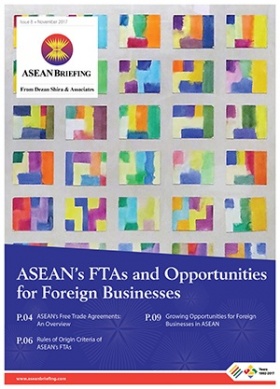EU-Singapore Free Trade Agreement Signed
On October 19, 2018, the European Union (EU) and the Republic of Singapore signed a free trade pact – the EU-Singapore Free Trade Agreement (EUSFTA) – to deepen the economic relations between the two regions. Along with this deal, two other agreements have been signed between the two sides – the EU-Singapore Investment Protection Agreement (EUSIPA) and the EU-Singapore Partnership and Cooperation Agreement (ESPCA). The trade pacts signal both sides’ strong commitment to free trade at a time of increasing protectionism and is also seen as a prelude to a future FTA between the EU and the Association of Southeast Asian Nations (ASEAN).
Ratification and coming into force
On February 13, 2019, the European Parliament approved the EUSFTA by a majority vote. The stage is now set for the final ratification and entry into force of the trade pact between the two jurisdictions.
The European Parliament on February 13, 2019 also approved the EUSIPA and the ESPCA. However, unlike the EUSFTA, these two agreements have to be ratified by the national parliaments of the individual EU member states before they could come into force.Trade links between Singapore and the EU
Singapore is the 14th largest trading partner of the EU for goods and the fourth largest for services. For Singapore, the EU is the country’s second largest trading partner for goods and the largest for services. More than 10,000 EU-based companies that use Singapore as a hub for Southeast Asia will highly benefit from the FTA. Besides, apart from Vietnam, Singapore is the only other ASEAN partner to sign an FTA with the EU.
The EU exported over Euro 33 billion worth of goods to Singapore and imported around Euro 20 billion worth of goods in 2017. This resulted in a positive trade balance for the EU of around Euro 13 billion. As regards services, the EU exported as much as it imported from Singapore – around Euro 20 billion – in 2016.
At the same time, foreign direct investment (FDI) play a major role in the economic relations between Singapore and the EU. In 2016, EU organizations invested more than Euro 167 billion in the Singaporean economy while at the same time receiving more than Euro 87 billion in inward FDI.
The trade volume between the two regions and the amount of mutual FDI makes Singapore a key player for EU trade activity in Asia.
The opportunities arising from EUSFTA
EUSFTA opens up both economies and contains some special provisions, which we will discuss in the following sections. Apart from the provisions regarding trade in goods and services, we will also focus on government procurement and geographical indications.
Trade in goods
The EU agreed to reduce its own tariffs to 0 within 5 years after the entry of force of the EUSFTA – cutting 75% of the tariff lines to 0% as soon as possible and the remaining tariff lines within three to five years. Some existing tariffs, especially on agricultural products, will remain. On the Singaporean side, more than 99% of all goods from the EU are already allowed duty-free access.
The agreement further aims at strengthening cooperation regarding regulatory standards as well as reducing unnecessary technical barriers to trade. Specific rules regarding food safety are also contained. EU standards for automobiles and automotive parts are accepted by Singapore. Electronics third-party testing will be replaced gradually in Singapore to comply with the EU rules. The EU further calls for greater transparency regarding pharmaceutical pricing. Furthermore, green technology must be treated the same as national products in both regions under the agreement.
Trade in services
Trade in services between the EU and Singapore is organized with a positive list. Everything on this list contains sectors that are opened up for competition from the partner countries. 12 sectors with more than 160 sub-sectors are included in this list. Amongst others, these are financial services, professional services, computer and related services, research and development, business services, telecommunication services, environmental services, and tourism and travel related services.
Postal service is also opened up on both sides, which is a sector mostly protected by states. Regarding e-commerce, the parties agreed on greater cooperation as well as to avoid imposing unnecessary restrictions and regulations. Free flow of information will be upheld under international standards of data protection.
Government procurement
Both parties are signatories of the Agreement on Government Procurement (GPA) of the WTO. This opens government procurement for goods and services under competitive bidding for certain sectors. In the EUSFTA, the EU extends this list to EU central government entities, city, and municipal level procurement, public works concessions such as railways, and some additional utilities. The EU dropped the threshold levels for bidding Singaporean companies.
Geographical indications
Geographical Indications (GIs) were one of the main negotiating planks of the EU-Singapore FTA. These are products only produced in a specific region that is protected as kind of trademark under GI. While the EU is the largest provider of these products, Singapore was not very welcoming of the idea. The EU list contains 196 GIs. Singapore ultimately added a list of 196 products to be granted GI status.
Investment protection agreement
The EUSIPA will replace 12 existing Bilateral Investment Agreements between Singapore and the EU member states. The agreement sets standards of fair and equitable treatment (FET) for investments amongst the signatories.
Protection against unreasonable expropriation is contained as well as the right to regulate of the states which says that states remain sovereign in their regulations and there is no possibility of investment arbitration regarding decisions on sovereign debt restructuring. If investment disputes arise, the concerned party has to refer the case to a tribunal, to be established under EUSFTA and which will deliver a decision in a pre-defined process. A major aim of the agreement is transparency during the disputes between investors and states.The EUSFTA and ASEAN
The EUSFTA is seen as a pathway to revive the suspended negotiations for an FTA between the EU and ASEAN. The talks on such an agreement started in 2007 and ended in 2009 due to difficulties in setting standards amongst the ASEAN countries. From that time on the EU tried to conclude national FTAs as a means to eventually come to the point of starting negations on an FTA for the entire ASEAN region. The recently finalized FTAs with Vietnam and Singapore mark a major step towards a common FTA between the EU and ASEAN in the future.
Editor’s Note: The article was first published on November 23, 2018 and has been updated on February 15, 2019 as per latest developments.
About Us
ASEAN Briefing is produced by Dezan Shira & Associates. The firm assists foreign investors throughout Asia and maintains offices throughout ASEAN, including in Singapore, Hanoi, Ho Chi Minh City and Jakarta. Please contact us at asia@dezshira.com or visit our website at www.dezshira.com.
- Previous Article Indonesiens Investitionsausblick für 2019
- Next Article Les perspectives d’investissement à Singapour pour 2019








